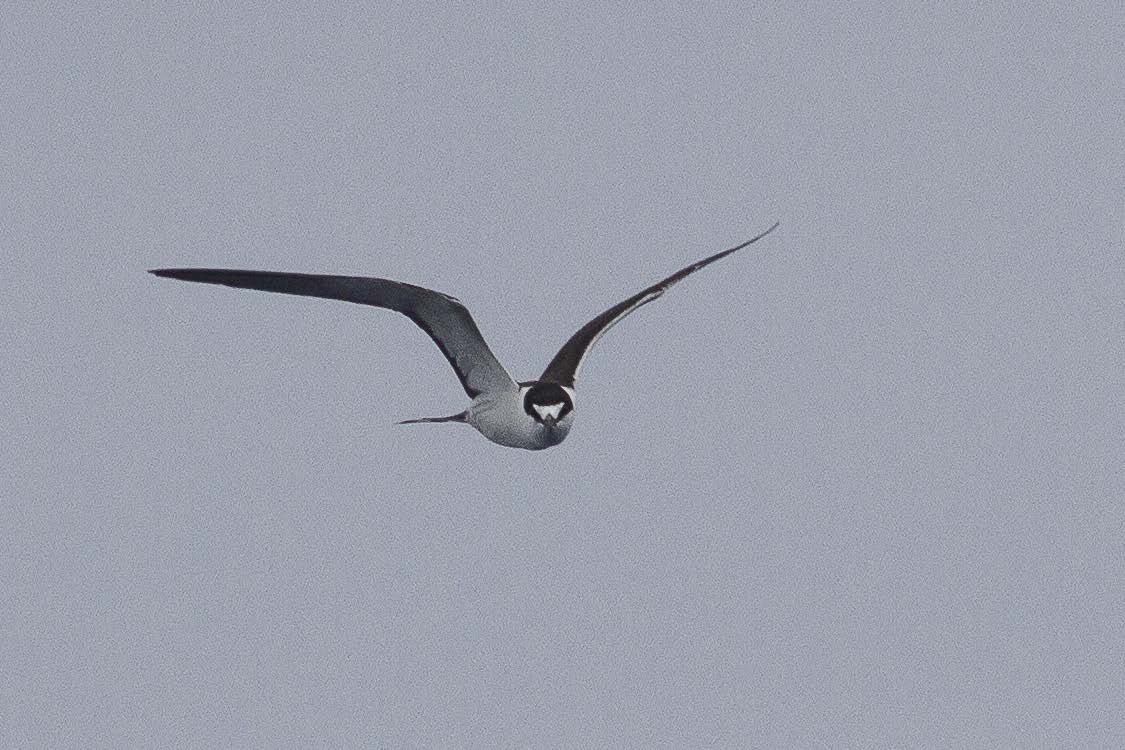ʻEwaʻewa

Names
- ʻŌlelo Hawaiʻi: ʻEwaʻewa
- Common: Sooty Tern
- Scientific: Onychoprion fuscatus, Sterna fuscata
Song
Conservation Status
- IUCN Red List Ranking – Least Concern
Species Information
The ‘ewa‘ewa or sooty tern is an abundant and gregarious tern (Family: Laridae) that lives in the tropical regions of both hemispheres, and is able to remain on the wing for years. Eight ‘ewa‘ewa (sooty tern) subspecies are recognized, and one (S. f. oahuensis) breeds in Hawai‘i. Individuals have long, slender wings and a deeply forked tail. Adult males and females are blackish above, except for white forehead and white on the edges of the outer most tail feathers, and entirely white below. The sharp bill, legs, and feet are black. Flight is characterized by powerful flapping, gliding and soaring, capable of long distance migration and breeding adults remain aloft between breeding seasons. Generally forages in hunting groups made of several species, typically feeding over schools of predatory fishes, especially yellowfin tuna (Neothunnus macropterus) and skipjack tuna (Katsuwonus pelamis). ‘Ewa‘ewa (sooty tern) feed primarily by seizing prey from the water or air while on the wing, infrequently by shallow dives; species’ plumage has poor waterproofing and easily becomes waterlogged. In Hawai‘i, ‘ewa‘ewa (sooty tern) diet consists of squid, goatfish, flyingfish, and mackerel scad. Nests in large, dense colonies consisting of thousands to a million pairs of terns. Individuals return to natal colony to breed, some long-term pair bonds have been documented, and breeders prefer to return to previous nest locations. Nests are shallow scrapes often lined with bits of shell or vegetation. Timing of breeding varies among years and locations, even within Hawai‘i, but generally eggs are laid beginning of February and most birds fledge by July. Both parents incubate single egg and brood and feed chick. Parents continue feeding young for two weeks after learning how to fly and young remain aloft until they return to breed. Birds first breed between four and ten years of age and the oldest known individual was 32 years old.
Distribution
‘Ewa‘ewa (sooty tern) breed throughout the NWHI and on Moku Manu off of the island of O‘ahu. Outside of Hawai‘i, ‘ewa‘ewa (sooty tern) breed on most islands throughout the world’s tropical oceans. Outside the breeding season, ‘ewa‘ewa (sooty tern) are highly pelagic.
Habitat
Terrestrial: ‘Ewa‘ewa (sooty tern) breed on oceanic islands and atolls. Nest is usually on sandy substrates with sparse vegetation. Marine: Pelagic.
Threats
- Introduced predators. Like all seabirds, adults and nests are susceptible to predation by rats (Rattus spp.) and feral cats (Felis silvestris). All sites in NWHI are free of rats and cats.
- Native predators. ‘Iwa or great frigatebirds (Fregata minor), cattle egrets (Bubulcus ibis), ‘akekeke or ruddy turnstones, (Arenaria interpres) ‘auku‘u or black-crowned night herons (Nycticorax nycticorax), Laysan (Telespiza cantans) and Nihoa (T. ultima) finches will depredate eggs and chicks.
- Overfishing. Because ‘ewa‘ewa (sooty terns) rely on predatory fish to drive prey to the surface, overfishing may eventually affect Hawaiian populations.
- Oil pollution. ‘Ewa‘ewa (sooty terns) populations are vulnerable to oil spills.
Plans & Projects
- Kauaʻi Endangered Seabird Recovery Project (KESRP)
- Maui Nui Seabird Recovery Project (MNSRP)
- Lehua Island Ecosystem Restoration Project
Photos
Additional Resources
For more information and references visit the DLNR State Wildlife Action Plan factsheets. DOFAWʻs species pages and State Wildlife Action Plan fact sheets are provided for general information and are not meant to be a citable, original source of data. If you are a student, researcher, or writer looking for a citable source, please explore the references below or find other original data sources, rather than citing these webpages. The references below were provided by the authors of the State Wildlife Action Plan fact sheets at the time of drafting:
- NatureServe. 2003. Downloadable animal data sets. NatureServe Central Databases. Available at: https://www.natureserve.org/getData/vertinvertdata.jsp (March 10, 2005).
- Schreiber EA, Feare DJ, Harrington BA, Murray BG, Robertson WB, Robertson MJ, Woolfenden GE. 2002. Sooty tern (Sterna fuscata). In The Birds of North America, No. 665 (Poole A, Gill F, editors.). Philadelphia, (PA): The Academy of Natural Sciences; and Washington DC: The American Ornithologists’ Union.
- U.S. Fish and Wildlife Service. 2005. Regional seabird conservation plan, Pacific Region. U.S. Fish and Wildlife Service, Migratory Birds and Habitat Programs, Pacific Region. Portland, (OR): U.S. Fish and Wildlife Service.

